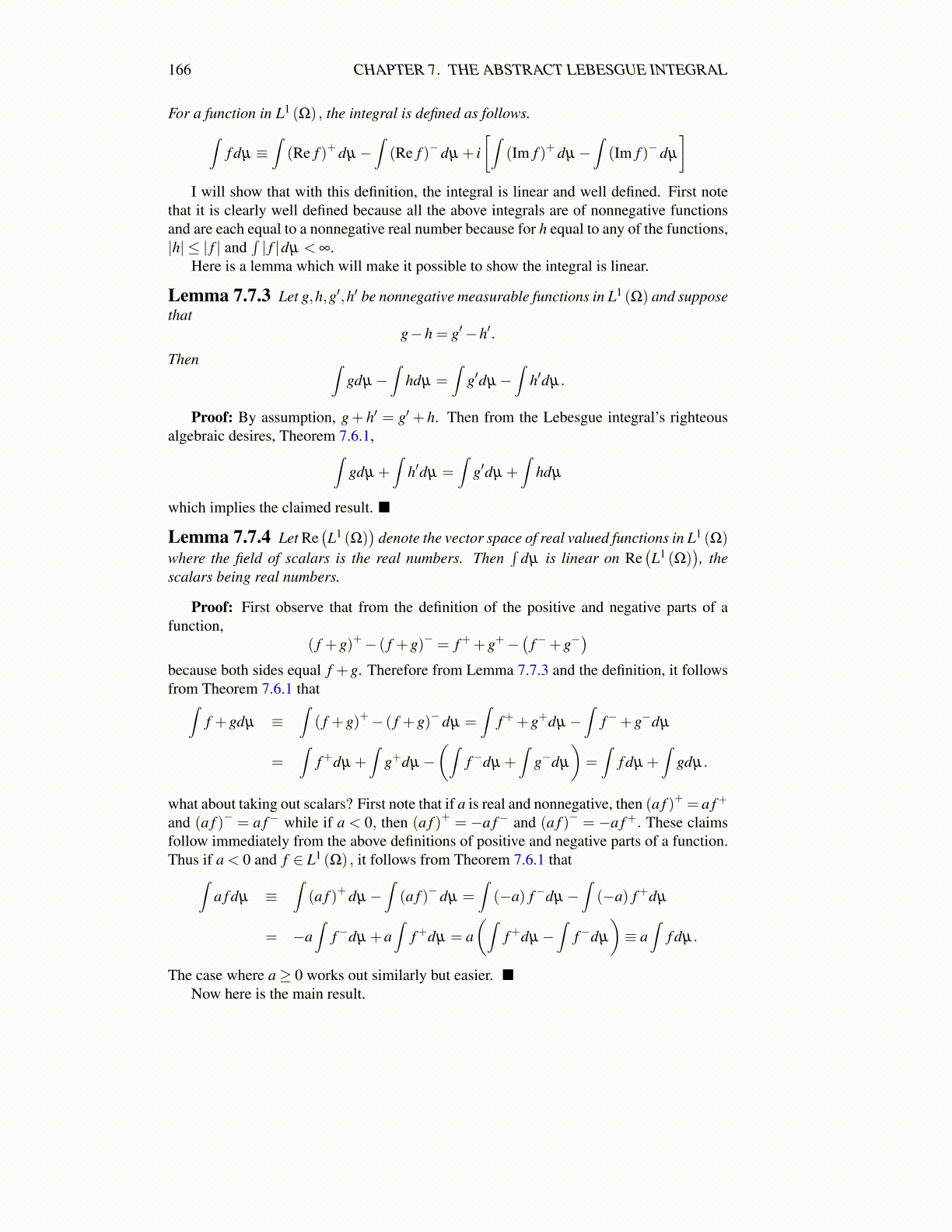
166 CHAPTER 7. THE ABSTRACT LEBESGUE INTEGRAL
For a function in L1 (Ω) , the integral is defined as follows.∫f dµ ≡
∫(Re f )+ dµ−
∫(Re f )− dµ + i
[∫(Im f )+ dµ−
∫(Im f )− dµ
]I will show that with this definition, the integral is linear and well defined. First note
that it is clearly well defined because all the above integrals are of nonnegative functionsand are each equal to a nonnegative real number because for h equal to any of the functions,|h| ≤ | f | and
∫| f |dµ < ∞.
Here is a lemma which will make it possible to show the integral is linear.
Lemma 7.7.3 Let g,h,g′,h′ be nonnegative measurable functions in L1 (Ω) and supposethat
g−h = g′−h′.
Then ∫gdµ−
∫hdµ =
∫g′dµ−
∫h′dµ.
Proof: By assumption, g+ h′ = g′+ h. Then from the Lebesgue integral’s righteousalgebraic desires, Theorem 7.6.1,∫
gdµ +∫
h′dµ =∫
g′dµ +∫
hdµ
which implies the claimed result. ■
Lemma 7.7.4 Let Re(L1 (Ω)
)denote the vector space of real valued functions in L1 (Ω)
where the field of scalars is the real numbers. Then∫
dµ is linear on Re(L1 (Ω)
), the
scalars being real numbers.
Proof: First observe that from the definition of the positive and negative parts of afunction,
( f +g)+− ( f +g)− = f++g+−(
f−+g−)
because both sides equal f +g. Therefore from Lemma 7.7.3 and the definition, it followsfrom Theorem 7.6.1 that∫
f +gdµ ≡∫
( f +g)+− ( f +g)− dµ =∫
f++g+dµ−∫
f−+g−dµ
=∫
f+dµ +∫
g+dµ−(∫
f−dµ +∫
g−dµ
)=∫
f dµ +∫
gdµ.
what about taking out scalars? First note that if a is real and nonnegative, then (a f )+ = a f+
and (a f )− = a f− while if a < 0, then (a f )+ = −a f− and (a f )− = −a f+. These claimsfollow immediately from the above definitions of positive and negative parts of a function.Thus if a < 0 and f ∈ L1 (Ω) , it follows from Theorem 7.6.1 that∫
a f dµ ≡∫
(a f )+ dµ−∫
(a f )− dµ =∫
(−a) f−dµ−∫
(−a) f+dµ
= −a∫
f−dµ +a∫
f+dµ = a(∫
f+dµ−∫
f−dµ
)≡ a
∫f dµ.
The case where a≥ 0 works out similarly but easier. ■Now here is the main result.